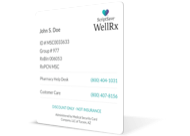Copyright 2024
Medical Security Card Company, LLC
All Rights Reserved
WellRx will never sell your personal information. Period. By signing up I agree to WellRx's terms of use and privacy policy.
By Jacquelyn Buffo, MS, LPC, CAADC
January 19, 2023
You may have noticed a change in your mood or energy levels now that the hustle and bustle of the holidays are over, the sun isn’t out, and the temperatures outside have dropped. If you find yourself feeling low energy, a lack of motivation, or poor concentration during a specific time of the year, you may be experiencing symptoms of seasonal affective disorder or SAD.
SAD is a diagnosable mental health condition that, if left untreated, can be detrimental to your overall health and well-being. We will look at SAD, including common symptoms, risk factors, prevalence, and treatment options.
Unfortunately, it is impossible to avoid and prevent feelings of sadness and fatigue. Additionally, it is both normal and common to experience temporary feelings of sadness, low mood, or low motivation. However, when the symptoms of low mood become chronic and start to negatively impact your ability to function in different areas of your life, you may have a diagnosable condition known as seasonal affective disorder or SAD. SAD can impact the way you feel, act, and think. SAD is a form of depression that impacts many people.
SAD refers to a change in your behavior and mood that usually occurs during the late fall or early winter months and resolves during the spring months, and it is a form of depression. Researchers believe that the reduction in sunlight during late fall and early winter months is a catalyst for SAD to develop. Interestingly, SAD can occur during the spring and summer months, which is referred to as summer-pattern SAD.
SAD is not a distinct diagnosis from depression. Rather it is a form of depression that falls under the category of major depressive disorder or MDD.
Common symptoms of MDD include:
Additional winter-pattern SAD symptoms can include:
Symptoms that are unique to summer-pattern SAD include the following symptoms:
Not everyone who has MDD has every symptom listed above. To be diagnosed with SAD, you must experience symptoms of MDD for at least 4-5 months throughout the year.
Like most mental health disorders, there isn’t one specific cause for SAD. However, researchers have identified risk factors that may make you more susceptible to developing SAD.
Risk factors for SAD are listed below:
Everyone who has the above-mentioned risk factors are not going to develop SAD. Additionally, researchers believe that sunlight is influential in the development of both patterns of SAD. Too much sunlight contributes to the development of summer-pattern SAD, and too little can contribute to the development of winter-pattern SAD.
SAD impacts many people across the United States. Statistics on the prevalence of SAD are listed below:
If you think you may be struggling with SAD, there are some things you can look out for. Some common ways symptoms of SAD present in your life may include:
Symptoms of SAD can look different for each person, and you should get help if you think you may be experiencing SAD symptoms. The severity of SAD symptoms can vary. If left untreated, SAD can significantly impact your health and overall functioning.
Talk to your doctor if you think you may be experiencing symptoms of SAD. Your doctor can provide you with an assessment to diagnose SAD, or they can refer you to a specialist who can. Your doctor may also be able to provide you with resources and supports to help manage and treat your symptoms. Remember that you are not alone and that depression of any kind is treatable.
Common treatment approaches for SAD and depression include a variety of interventions such as:
Psychotherapies help you develop the skills necessary to cope with negative emotions and thoughts. Cognitive behavioral therapy, or CBT, is a common psychotherapy that is often used in the treatment of SAD. Treatment occurs in the group setting and includes a group CBT session every two weeks for six weeks.
Light therapy involves you sitting in front of a therapy light for approximately 30-45 minutes each day beginning in the fall and lasting through spring. Therapy lights can usually be found in stores on online retail platforms.
As previously mentioned, vitamin D deficiency has been thought to be a contributing factor to the development of SAD. Therefore, vitamin D supplements may help regulate and improve SAD symptoms. However, research on the efficacy of vitamin D shows mixed results, and it is unclear how effective it is in treating SAD symptoms.
Common medications used to treat SAD include selective serotonin reuptake inhibitors or SSRIs, which are also known as anti-depressants. Common SSRI medications prescribed to treat SAD include:
You and your doctor will develop a comprehensive treatment plan that addresses all of your unique needs. Everyone’s treatment plan is different, and interventions that work for one person may not be right for you. If you and your doctor determine that medication is appropriate for you, ScriptSave WellRx can help you save up to 80% on your prescription medications. Most people who utilize the prescription discount cards offered by ScriptSave WellRx save around 65% on their medications.
If you are experiencing suicidal thoughts, seek help immediately. You can call or text 988 to speak with a trained and compassionate crisis counselor who can support you. You can also access the online chat here. Help is available 24 hours a day, 7 days a week via chat, phone, or text messages. Your life matters and help is available to you if you are struggling with depression or any other mental or behavioral health disorder. You are not alone.
Jacquelyn B. began writing at the age of 10 when she won a county-wide essay contest explaining why her mother is worth her weight in gold. Since that time, she has written for several newspapers and a health and wellness blog. Her education and experience is in mental health and addiction. She is a licensed counselor and currently provides therapeutic services on an outpatient basis. Her counseling and substance abuse experience includes inpatient residential, in-home, and early recovery counseling. She is a certified addiction specialist and is working on obtaining her certification in Dialectical Behavioral Therapy. She also specializes in working with pregnant and post-partum women and has received advanced training on women's health.
Resources:

For your convenience, use the ScriptSave® WellRx mobile app. Now savings are well in hand, right at the pharmacy counter. Save on your family's prescription medicines.
Learn More
Your choice. Get a ScriptSave WellRx Savings Card. Or Download the free mobile app from the App Store or Google Play Store
Get A Card
ScriptSave WellRx Grocery Guidance leverages leading-edge nutritional data science to help you know which food products on your grocery store shelf are truly good for YOU.
Healthy Foods For YouTags:

November 07, 2024

October 23, 2024

May 07, 2024
You need to log into the site to use this feature
This feature requires registration. Sign up or log in to your free WellRx account to gain access to this and other tools to help make managing your medications and wellness easier.
Benefits Include:
 Store & manage your medication list
Store & manage your medication list
 Medication pricing updates
Medication pricing updates
 Medication information
Medication information
 Pill & refill reminders
Pill & refill reminders
 Medication journal & mood log
Medication journal & mood log
This feature requires registration. Sign up or log in to your free WellRx account to gain access to this and other tools to help make managing your medications and wellness easier.
Benefits Include:
 Store & manage your medication list
Store & manage your medication list
 Medication pricing updates
Medication pricing updates
 Medication information
Medication information
 Pill & refill reminders
Pill & refill reminders
 Medication journal & mood log
Medication journal & mood log
You will be redirected to your program in 5 seconds.
Our Terms and Conditions and Privacy Policy have recently been updated.
By declining you will be logged out of your account